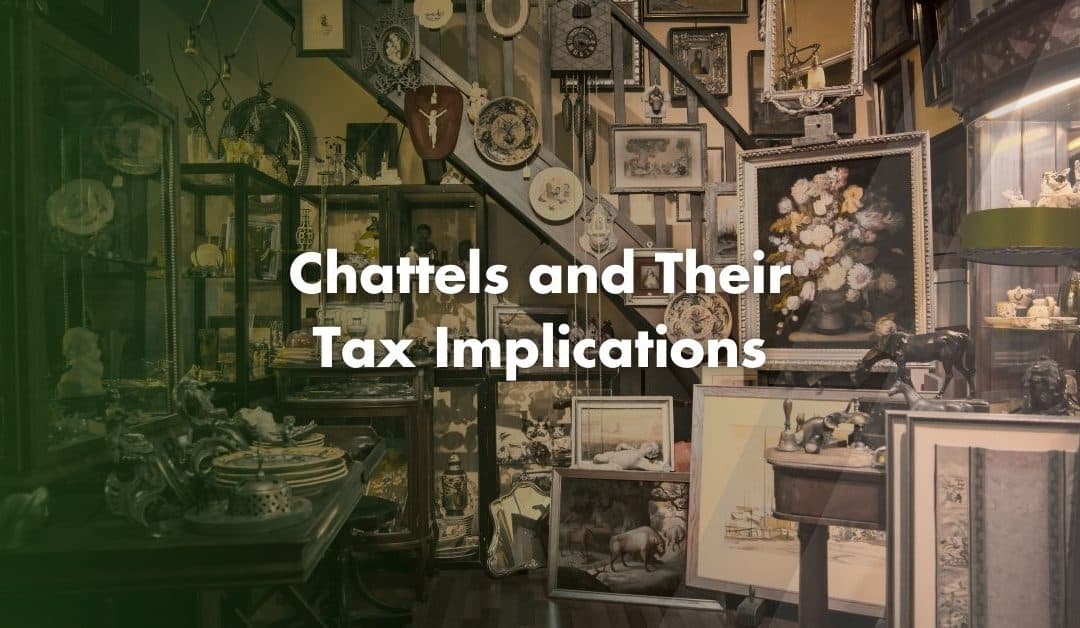Chattels may seem like a niche topic, but they affect many people who buy, sell or inherit valuable items. If you sell or dispose of an asset for more than you paid for it, you make a profit called a “gain”. That gain may be subject to Capital Gains Tax.
Understanding chattels and their tax treatment can save you money and keep you compliant with HMRC.
What are Chattels?
Chattels are tangible, moveable objects. In other words, a physical item that you can touch and move. Examples include:
- Paintings
- Jewellery
- Antiques
- Vehicles
- Furniture
A house is not a chattel because it is fixed in place. Digital assets also do not count because they are not physical.
If a once-moveable items becomes permanently attached to land or a building, it loses its chattel status. So, if you fix a sculpture into a wall, it becomes part of the property and is no longer treatable as a chattel for tax purposes.
How Capital Gains Tax Applies to Chattels
When you sell, gift or otherwise dispose of a chattel and make a profit, you may owe Capital Gains Tax. The amount of tax depends on your total gains for the year and your Annual Exempt Amount (AEA).
Important: Capital Gains Tax only applies to your gain, not the full sale price.
The Annual Exempt Amount represents the tax-free limit for gains in a tax year. For 2025/26, individuals can make up to £3,000 in gains before Capital Gains Tax applies, while trustees can make up to £1,500. If your total gains are below your allowance, you do not need to report or pay tax.
However, as the allowance has reduced in recent year, more people may now find themselves within the Capital Gains Tax threshold.
Calculating Your Gain
Capital Gains Tax is chargeable on the profit, not the total sale proceeds. The gain equals your sale price minus what you paid for the item, plus any related costs for buying, improving or selling it.
For example: You buy a painting at auction for £10,000 and pay a £1,000 buyer’s premium. You then spend £4,000 on restoration and later sell it for £25,000. The selling platform charges £2,500 commission, bringing your total costs to £17,500. Your gain is £7,500. After subtracting your £3,000 allowance, you will pay Capital Gains Tax on the remaining £4,500.
If multiple people own the same item, each person’s share of the gain has a separate calculation.
Wasting Chattels
Wasting chattels have a predictable lifespan of less than 50 years. Common examples include machinery and vehicles. Because these items typically lose value over time, gains from selling them are usually exempt from Capital Gains Tax.
However, if you use such an asset for business purposes and claim Capital Allowances, you will lose the exemption. In that case, you will need to declare the gain and may face additional tax known as a Balancing Charge.
Even if certain assets, such as clocks or boats, increase in value, they still count as wasting chattels. Unless used for business, any profit from their sale remains exempt from Capital Gains Tax.
Non-Wasting Chattels
Non-wasting chattels have an expected lifespan of more than 50 years. Common examples include fine art, antiques and jewellery. These items may attract Capital Gains Tax depending on the sale value.
Tax may apply if you sell a non-wasting chattel for more than £6,000. However, the gain is tax-free if you it for less than £6,000. There is also the special 5/3 rule. When an item bought for less than £6,000 sells for more, your gains caps at five-thirds of the difference between the sale price and £6,000.
Intended Use and Its Impact
Your intended use for an asset affects whether it is a wasting or non-wasting chattel. If you buy a motorcycle to ride daily, it is a wasting chattel because it has an expected lire under 50 years. But if you buy the same bike as a long-term investment, it could be non-wasting. The intended purpose at the time of purchase determines the treatment.
Chattel Sets and Collections
If you sell a set of similar and complementary items, such as matching ornaments or books by the same author, HMRC treats the set as one asset. The £6,000 exemption applies to the set as a whole, not to each piece individually. This means that selling several parts of a valuable collection can push you over the tax threshold even if each item sells for less than £6,000.
Disposing of Assets Without Selling
You do not need to sell an item to trigger Capital Gains Tax. Giving away or transferring ownership can also count as a disposal. In these cases, HMRC uses the item’s market value at the time of transfer to calculate your gain. Even if you receive no money, you might still owe tax if the asset has increased in value.
Contact Us
We are not just accountants; we are Chartered Accountants with one of the most reputable and premium accounting bodies. We are registered and regulated by ACCA; so you can rest assured that you are in good hands. Knowing this, don’t hesitate to get in touch with us if you require assistance: Pi Accountancy | Contact Us
This article is for general informational purposes only and does not constitute legal or financial advice. While we aim to keep our content up to date and accurate, UK tax laws and regulations are subject to change. Please speak to an accountant or tax professional for advice tailored to your individual circumstances. Pi Accountancy accepts no responsibility for any issues arising from reliance on the information provided.

